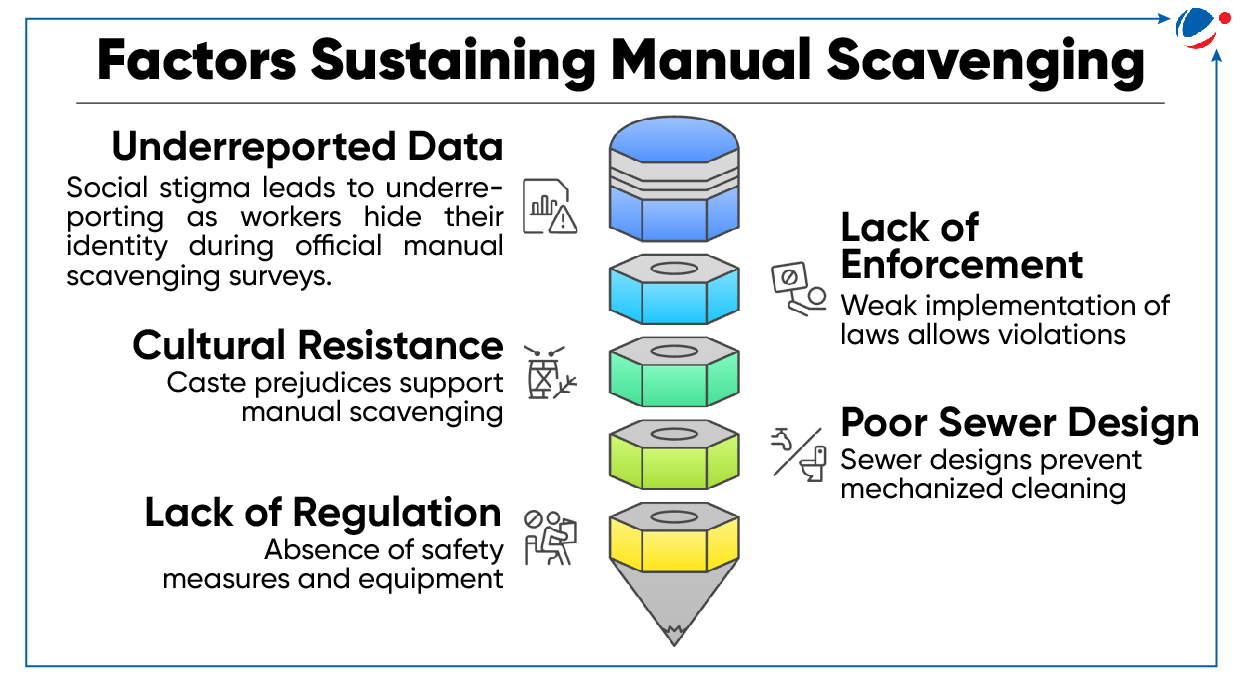Why in the News?
A Bench of Supreme Court sought an action taken report on each of its directions issued on Dr Balram Singh V. Union of India & Ors (2023) case
Directions issued in Dr Balram Singh V. Union of India & Ors (2023) case
- Apex court had issued directions to the Union and States to take measures to eradicate manual scavenging and hazardous cleaning in the country.
- The Union, State and Union Territories are directed to ensure that full rehabilitation (including employment to the next of kin, education to the wards, and skill training) measures are taken in respect of sewage workers, and those who die.
- Enhances the compensation payable for sewer deaths to ₹30 lakh from the earlier ₹10 lakh.
- In the case of sewer victims suffering disabilities, enhances compensation to ₹ 20 lakhs from earlier ₹ 10 lakhs.
- Conduct a comprehensive national survey within one year to identify manual scavengers across states and union territories.
- NCSK, NCSC, NCST and the Union government are required to coordinate and prepare training and education modules, for information and use by district and state level agencies, under the 2013 Act.
About Manual Scavenging
- As per Prohibition of Employment as Manual Scavengers and their Rehabilitation (PEMSR) Act, 2013, Manual scavenging refers to the practice of manually cleaning, carrying, or handling human excreta from insanitary latrines, open drains, or pits.
- Manual Scavenging being officially banned since 1993 under the Employment of Manual Scavengers and its Prohibition Act (1993).
- As on 31.07.2024, out of 766 districts in the country, 732 districts have reported themselves as manual scavenging-free.
Government Steps to end manual scavenging
- Legislative Measures
- Prohibition of Employment as Manual Scavengers and their Rehabilitation Act, 2013: Provide for the prohibition of employment as manual scavengers, rehabilitation of manual scavengers and their families.
- Every offence under act is a cognizable and non-bailable offence.
- Employment of Manual Scavengers and Construction of Dry Latrines (Prohibition) Act, 1993: Act prescribes punishment to individual who employs manual scavengers as well as to those who construct dry toilets or latrines.
- Others: The protection of Civil Rights Act, 1955; The SC/ST (Prevention of Atrocities) Act, 1989; etc.
- Prohibition of Employment as Manual Scavengers and their Rehabilitation Act, 2013: Provide for the prohibition of employment as manual scavengers, rehabilitation of manual scavengers and their families.
- Schemes
- National Action for Mechanised Sanitation Ecosystem( NAMASTE scheme) 2023:A Central Sector Scheme, implemented by National Safai Karamchari Financial Development Corporation under Social Justice Ministry.
- To ensure safety, dignity and rehabilitation of hazardous sanitation workers.
- Swachh Bharat Mission (Urban 2.0): Funds amounting to Rs 371 Cr have been approved for release to States to be provided to smaller towns to acquire the machines and improve their state of mechanization.
- National Action for Mechanised Sanitation Ecosystem( NAMASTE scheme) 2023:A Central Sector Scheme, implemented by National Safai Karamchari Financial Development Corporation under Social Justice Ministry.
- Dedicated institution
- National Commission for Safai Karamcharis (NCSK): Initially created as a statutory body in 1994 for three year, became a non-statutory body under Social Justice Ministry after its Act lapsed.
- National Safai Karamchari Financial Development Corporation(1997): operates as a non-profit company under Social Justice Ministry to uplift Safai Karamcharis through various loan and non-loan based schemes.

Way Forward
- As per National Human Rights Commission Suggestions
- The distinction between sanitation workers and manual scavengers in the 2013 Act is necessary.
- Empanelment of de-sledging market and regulating its operations.
- Providing of safety gear and conducting of awareness workshops.
- Give financial assistance to those coming up with technological innovations for hazardous waste cleaning.
- Technological intervention: Modern sanitation technologies such as automated sewer cleaning machines and robots can significantly reduce the dependence on human labour for cleaning sewers and septic tanks.
- Example like Kerala's Bandicoot, which a robotic scavenger.
- Upgrading sanitation infrastructure: Investments in improved sanitation infrastructure, including sewage and sewage treatment systems.
- Survey and Identification of Manual Scavengers: Periodic surveys to identify manual scavengers across India to ensure they receive benefits under rehabilitation schemes. Last survey was conducted in 2018.



